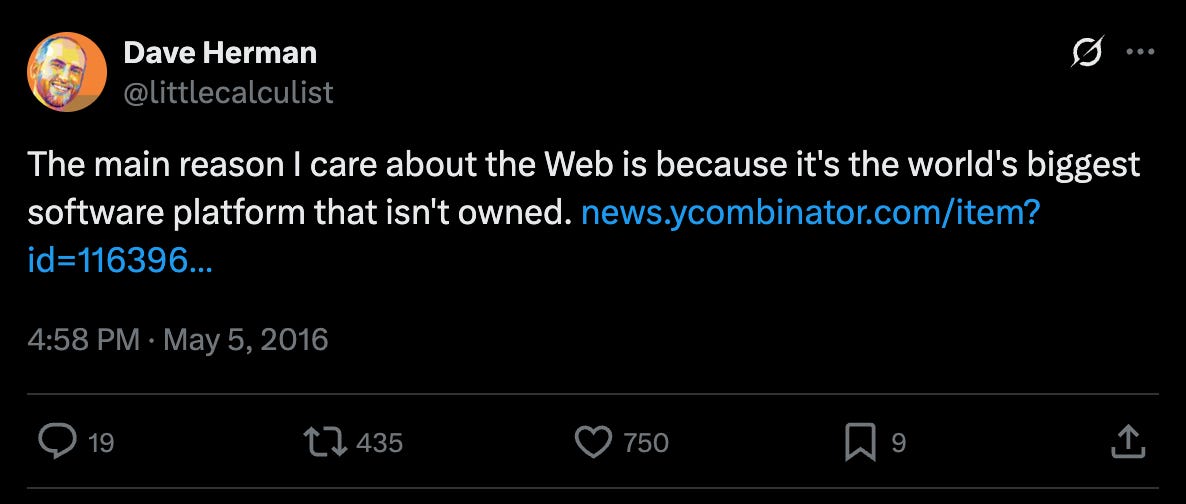World Wide Intelligence
If the WWW created hyper-communication, then WWI could create hyper-coordination
The Web is the world’s biggest software platform that isn’t owned.
But not for long. Artificial Intelligence at scale has the potential to be the next biggest software platform that isn’t owned, if we take some inspiration from the guys who invented the internet.
We can build a web-like network of intelligences that surpass the wildest dreams of the HTTP protocol and hypertext. Information and intents will be passed through an intelligent network of nodes like gossip; intelligent routers will collect and aggregate resources from all across the network to complete the request.
Anyone can participate in the network by hosting resources (like the traditional web we know and love) or contributing intelligence, like BitTorrent. Maybe we embed the intelligence into the router directly.
But I’m getting ahead of myself. Why is this like the web? And why is this worth doing? Why not just use artificial intelligence by making HTTP streaming requests at the app layer like we are doing now?
And what is it exactly that the inventors of the web did?
They decentralized all human communication.
Just think about that for a second. They decentralized all communication. Forever. Before the internet, you needed to send your communications through a centralized, hierarchical network of automated switchboards operated by AT&T. This means at least three bad things:
you are restricted from building whatever you want on top of their infrastructure, at risk of breaking their "terms of service”
the whole network is vulnerable to attack1 due to centralized points of failure everywhere in the hierarchy
You need to spend a huge amount of money to protect the vulnerable AT&T switching stations, literally encasing them in bricks or putting them underground
But Paul Baran at Rand had another idea…
Baran flipped all of this on its head. Instead of a static network with hardened switching stations, he proposed a dynamic network with disposable routers that could freely join or leave. Instead of centralized routing, he proposed dynamic ad-hoc software-based routing.
Messages would be broken up into little packets, and each packet would be wrapped in a header envelope describing its desired destination. A router receiving a packet would independently choose where to send it next, like gossip. Packets would be passed across the network like hot potatoes until they found their destination. Packet switching!Now it didn’t much matter if a router was blown up. Routes were ad-hoc, so the network could dynamically route around the damage. New routers could freely join. The network could adapt to new conditions.
What is strange is that by optimizing for decentralization, redundancy, diversity, adaptability, Baran’s network design created the conditions for permissionless innovation and the vibrant commercialized internet we have today.
— Decentralization Enables Permissionless Innovation — Gordon Brander
Remember how routers independently choose where to send information, like gossip. This will be important later.

We Can Do Better Than HTTP:
The main way we communicate on the internet today is a communication protocol called HTTP (or Hypertext Transfer Protocol), invented by Tim Berners Lee, the founder of the World Wide Web. The World Wide Web is actually 4 seperate inventions, all invented at once, and complimenting each other:2
A textual format to represent hypertext documents, the HyperText Markup Language (HTML).
A protocol to exchange these documents, the HyperText Transfer Protocol (HTTP).
A client to display (and edit) these documents, the first web browser called the WorldWideWeb.
A server to give access to the document, an early version of httpd.
Hmm, that’s weird. It appears the entire web was built to help us request and transfer documents stored at specific URLs (or Uniform Resource Locators).
But then… what if the document doesn’t have the information I wanted? Can the network help? Or what if the URL was moved, can the network help? What if I don’t know what format the resource is going to be in, and I need to read it, can the network help? What if I don’t know where a document is, like I don’t know its URL, can the network help?
No, no, no, and no.
If a resource is missing the info you want, then you need to go request a new resource by hand, and you need to find the new URL yourself. If you request a resource and it doesn’t exist, you get a 404 not found error. If you request a resource and you don’t know the format, then you have to do what we call “plumbing” work to painstakingly define the interface in your own code, or else you have unreadable junk and run-time errors. If you don’t know where a resource is located, then you need to go use an APP-LAYER solution, like a search engine to find its URL, because the network can’t help you.
We can do better. We can build intelligence into the network-layer.
A Protocol for Networked Intelligence:
So the HTTP model roughly works like this:
Client requests a resource from a specific URL
Server returns that specific resource or an error code
The client needs to painstakingly plan everything in advance, and if the resource changes, the client’s code breaks. This leads us to centrally plan all our APIs, which prevents innovation and decentralization of resources. The network begins to resemble a stagnant, centrally planned city of “resources”, rather than an ecosystem:
Instead, you could imagine a new model, called the Intelligence Transport Protocol (ITP):
Client expresses an information need from the network (not just a URL)
The network sends it around like gossip/rumour (remember packet switching!!), and through distributed intelligence - interprets, routes, aggregates, and enhances that request with as much compute cost across as large a span of the network as the client was willing to pay/wait for (and we can all contribute compute to the network like BitTorrent)
The network maintains registries of resources, so it can fetch any traditional HTTP/REST resource3
The network streams back progressively better responses in exactly the shape that the client asked for (no need to look up the documentation for a schema, ever again), along with sources/citations to any resources that were used to create the response
In this protocol, any number of intelligent nodes can contribute to fulfilling an information request the best they can without any centralized coordination, or any single point of failure. You get to surf every model, every search engine, and every resource at once. You get to surf the intelligence of the entire network, combined.
Remember how the inventors of the internet decentralized all human point-to-point communication, forever?
I dream of a world where we decentralize all many-to-many human coordinations, forever. You should never need to go through a central app authority to “search” for resources. You should never need to go through a central app authority to “find” your friends. Or to “connect” with colleagues in your industry.
To be clear, there will still be apps, but they will be built on top of a network that can intelligently coordinate to complete any arbitrary request or intent, by using and accessing any amount of arbitrary resources, anywhere in the network, and then combining their results to fulfill the intent. This coordination is only constrained by cost of compute and trust, but so is the internet. We will figure these out.
Hyper-communication evolved inside of a decentralized protocol — the internet. It never would have evolved inside of AT&T.
Hyper-coordination will also evolve inside of a new decentralized protocol. Hyper-coordination will never evolve inside of a centralized entity.
Thank you for reading, I welcome any and all comments. If you want more analysis on the future of AI and networks, that will probably be happening here, so subscribe!
for instance by Russia during the cold war
https://developer.mozilla.org/en-US/docs/Web/HTTP/Guides/Evolution_of_HTTP
This is reminiscent of MCP, except MCP is an app-layer solution, so it runs on centralized infrastructure, and this is a network-layer solution.




> what is it exactly that the inventors of the web did?. They decentralized all communication. Forever.
well, about that...
What's the systemic force that keeps the world-wide intelligence from centralizing in the same way that the www did, due to a combination of network effects, trust dynamics, and increasing returns to compute scale?